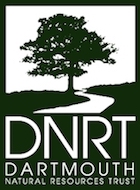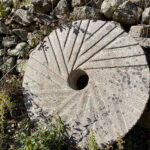Allen’s Mill
 Allen’s Mill is part of DNRT’s Destruction Brook Woods property, but is accessed via a separate parking area and not connected by trail to the rest of Destruction Brook Woods.
Allen’s Mill is part of DNRT’s Destruction Brook Woods property, but is accessed via a separate parking area and not connected by trail to the rest of Destruction Brook Woods.
Location : Slade’s Corner Road | View Google Map
Year Acquired : 2000 (as part of Destruction Brook Woods acquisition)
Access Point : Parking area on the north side of Slade’s Corner Road, approximately 4/10ths of a mile from Russell’s Mill Village. A very short loop trail goes around the mill building. Periodically, DNRT opens the mill building for educational tours. (Please do not walk up or along the driveway! It is private property.)
Description
Allen’s Mill is a small piece of the 283-acre Destruction Brook Woods Reserve, but a large part of the area’s identity. Russells Mills Village was one of the first recorded settlements in Dartmouth, named after local miller Joseph Russell. As the village was being established, one of the first orders of business was to construct a mill.
Johnny Cake meal, made from a hard kernel corn, aptly named flint corn, was one of the products produced at the mill. Not only was the mill the place in town to grind down corn into Johnny Cake meal and flour, but it also acted as a town center. Town notices were posted, and many gathered to catch up on the local gossip.
Throughout the years, over 30 mills were established in Dartmouth alone. Many have been lost to time with only their foundations left. The only mill still standing in its entirety is Allen’s Mill.
Mill Mechanics
 Located alongside Destruction Brook, Allen’s Mill is in a prime spot for water power. The fall, or head, created by the height of the 17-foot waterfall onto the waterwheel was unmatched in the area.
Located alongside Destruction Brook, Allen’s Mill is in a prime spot for water power. The fall, or head, created by the height of the 17-foot waterfall onto the waterwheel was unmatched in the area.
This mill featured an overshot waterwheel and had three retaining ponds constructed to maintain or increase the flow of water to the mill. The outlet of each of these ponds has a structure known as a spillway, which holds boards in place that can later be removed to adjust the water level and increase the flow to the mill. The flow of water would run through the raceway, a man-made channel that extended the waterway, and drop water on top of the waterwheel causing it to turn.
The spinning of the wheel turned the horizontal shaft while the gear system transferred the momentum to a vertical shaft. This in turn spun the top runner stone while the bottom, or bedstone, remained still. At one time the mill had two sets of stones in operation and a machine used to grind whole corncobs for cattle meal. One set of stones was used to grind oats and wheat for farm meal, and the other for Johnny Cake meal. Grains, in this case mostly corn, were dried by their respective farmers before being brought to the mill.
After corn was shucked, a bag of kernels would be fed into the hopper and then land in a shoe below, and with the gentle rocking of a damsel, would be fed into the center, or eye, of the millstones. This system allowed the miller to fill the hopper without worrying about jamming the stones, as the shoe and damsel measured the feed into the grinding stones. What would be produced from the grind would find its way to a spout at the side of the stones and into a bin for later packaging. The miller could control the rate of feed going into the mill stones using a pulley that was connected to the shoe.
A Brief History of Allen’s Mill

James Allen
Over the years the Allen’s Mill property had various owners, Matthew Wing being one of the first documented (1696). Wing had married Elizabeth Mott, whose late husband William Ricketson constructed the mill. In 1711, control of the mill was transferred from Wing to Ricketson’s son Jonathan. At this time the mill was known as Ricketson’s Mill. Not much is known about the next few proprietors, other than their ownership of the property.
William Spooner owned the mill for 15 years before the deed was transferred to David Akin. Akin then moved to New York and gifted the mill to his son, Josais Akin. Daniel Russell later acquired the mill and passed the mill onto Nicholas Howland in 1767. The next deed was drawn in 1784 between previous two owner’s sons, Giles Russell and Johnathan and Timothy Howland. The mill would then stay in the Howland family for over a century, spanning generations. Allen Howland, son of Timothy, would eventually take over the mill before passing it down to his son, Elihu.

James Allen II purchased the mill in 1876 and his name is still associated with the mill to this day.
In 1936 the property was sold to John Sheehan, the final miller at Allen’s Mill. At an undocumented time, a sawmill was constructed and also operated at Allen’s Mill. This lumber was used to construct many homes in the area.
In 1939, a fire burned down the sawmill along with a corner of the gristmill. Miller John Sheehan also happened to be the fire chief at the time and fought the fire at his own mill.

The saw mill was partially reconstructed and the gristmill was repaired. The mill operated until sometime in the 1950s before operation slowed to a halt and the building fell into disrepair.
Restoration Efforts
There has been a mill at the Allen’s Mill site for over 300 years. Over the course of time, the building has been exposed to much destruction (and we’re not just talking about Destruction Brook!).
In 2000, DNRT purchased the 283-acre Destruction Brook Woods Reserve and with it acquired Allen’s Mill. After a few years of hard work, planning, and the funding of many invested individuals, including a Community Preservation Committee grant, restoration began to rebuild Allen’s Mill to its 1800s appearance.

In 2004, the mill was partially reconstructed, with the main building reassembled. Restoration efforts were completed in 2011 with the construction of the mill shed and a boardwalk crossing in front of the building. Despite the destruction and wear and tear that Allen’s Mill saw throughout the years, the building was restored and has become a model into the not-so distant past.
Anecdotes
Today it’s hard for most people to imagine growing your own produce, raising livestock, and bringing your crop to the local mill to make flour, meal, or animal feed when almost anything you could want can be delivered to your door, next day, without ever leaving your home. But this was the case not so long ago. There are a few Dartmouth locals who still remember when Allen’s Mill was in operation.
We went down the mill and we helped Jack do the cornmeal, put them in the bags, weighed them.
– Nancy Vieira, mill neighbor
Our [Marian’s and Nancy Vieira’s (sisters)] pay was the Johnny Cake meal.
– Marian Hubbard, mill neighbor
Johnny Cake meal was a very big staple back in those days and before that. Everybody made Johnny Cakes. And it’s interesting that, I don’t know if it’s folklore or if it’s true or not, but the original name for them was Journey Cakes. And that’s because they would keep.
– Allen Manley, former Allen’s Mill employee
Oh, I can tell you about grain bags. We had clothes made out of those all the time. You’d have to make sure you saved enough of them and my sisters and I, our outfits all looked alike.
– Cathy Costa, mill customer
The corn we raised, we’d take it down to the mill to get it ground…We’d put it in the corncrib and then we had to go out there and husk it. Then if we wanted it shelled so we could take it down to the mill to grind for cornmeal we’d put it through a corn sheller. Started a crank and put the corn ears in and they’d strip the kernels off the cobs.
– Horace Wildes, mill customer






